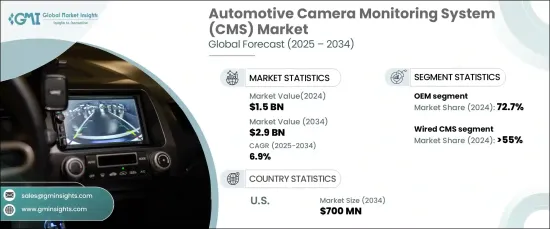
세계의 자동차용 카메라 모니터링 시스템 시장은 2024년에 15억 달러로 평가되며, 2025-2034년에 CAGR 6.9%로 확대할 것으로 예측됩니다.
이러한 성장은 자동차 부문 전반에 걸쳐 첨단운전자보조시스템(ADAS)의 채택이 증가하고 있는 것이 주요 요인으로 작용하고 있습니다. 이러한 시스템에는 자동 브레이크, 어댑티브 크루즈 컨트롤, 차선 유지 지원 등의 기능이 포함되며, 카메라 모니터링 시스템은 사각지대 감지 및 충돌 방지와 같은 기능에서 중요한 역할을 하고 있습니다. 교통안전 강화에 중점을 둔 정부 규제는 이러한 기술에 대한 수요를 더욱 증가시키고 있습니다. 세계 각국의 엄격한 정책으로 인해 자동차 제조업체들은 신차 및 기존 모델 모두에 카메라 기반 시스템을 탑재할 수밖에 없는 상황에 처해 있습니다. 기존 미러에서 카메라 기반 시스템으로 전환하는 것은 이러한 규제와 일치하며, 이는 시장에 큰 성장 기회를 제공합니다.

시장은 기술별로 유선 시스템과 무선 시스템으로 분류됩니다. 유선 시스템은 안전에 중요한 용도에서 신뢰성과 안정적인 성능으로 인해 2024년 시장 점유율의 55% 이상을 차지하고 있습니다. 이러한 시스템은 실시간 비디오 피드가 필수적인 상용차에서 널리 사용되고 있습니다. 간섭 없이 안정적인 데이터 전송이 가능하므로 대형 차량을 사용하는 용도에 필수적입니다.
| 시장 범위 | |
|---|---|
| 시작연도 | 2024년 |
| 예측연도 | 2025-2034년 |
| 시작 금액 | 15억 달러 |
| 예상 금액 | 29억 달러 |
| CAGR | 6.9% |
반면, 무선 시스템은 설치의 용이성과 미적 장점으로 인해 인기가 크게 증가하고 있습니다. 이러한 시스템은 대규모 배선의 필요성을 없애고 깔끔한 디자인에 기여하므로 승용차 및 애프터마켓 솔루션에서 특히 선호되고 있습니다. 자율주행, 차량 간 통신 등 커넥티드 차량 기술이 점점 더 중요해짐에 따라 무선 시스템의 채택이 더욱 확대될 것으로 예상됩니다. 이러한 추세는 유연성과 고급 기능이 우선시되는 소비자 차량 및 개조 시장에서 특히 두드러지게 나타나고 있습니다.
카메라 모니터링 시스템의 유통은 주문자 상표 부착 생산업체(OEM)와 애프터마켓으로 나뉘는데, OEM은 2024년 기준 72.7%의 점유율을 차지하며 시장을 독점하고 있으며, 이는 주로 새로 생산되는 자동차에 첨단 안전 시스템이 내장되어 있기 때문입니다. 자동차 제조업체들은 특히 전기자동차 및 자율주행 모델에서 엄격한 안전 기준을 충족하고 차량 성능을 향상시키기 위해 카메라 모니터링 시스템을 적극적으로 통합하고 있습니다. 애프터마켓 역시 업그레이드 및 진화하는 안전 규정 준수를 원하는 소비자 수요에 힘입어 성장세를 보이고 있습니다. 애프터마켓 솔루션은 안전과 기능성을 향상시키고자 하는 차량 소유주들 사이에서 인기를 얻고 있습니다.
미국에서는 엄격한 안전 기준과 첨단 차량 기술에 대한 관심이 높아짐에 따라 2034년까지 약 7억 달러 규모에 달할 것으로 예상됩니다. 안전성이 강화된 차량에 대한 소비자의 관심 증가와 규제 요건이 이러한 성장 궤도를 지원하는 주요 요인입니다.
The Global Automotive Camera Monitoring System Market was valued at USD 1.5 billion in 2024 and is projected to expand at a CAGR of 6.9% from 2025 to 2034. This growth is largely driven by the increasing adoption of advanced driver-assistance systems (ADAS) across the automotive sector. These systems include features like automatic braking, adaptive cruise control, and lane-keeping assist, where camera monitoring systems play a vital role in functions such as blind-spot detection and collision avoidance. Government regulations focused on enhancing road safety further bolster the demand for these technologies. Stricter policies from global bodies are compelling automakers to incorporate camera-based systems into both new and existing vehicle models. The shift from traditional mirrors to camera-based systems aligns with these regulations, creating substantial growth opportunities for the market.

The market is categorized by technology into wired and wireless systems. Wired systems held over 55% of the market share in 2024 due to their reliability and stable performance in safety-critical applications. These systems are widely used in commercial vehicles, where real-time video feeds are essential. Their ability to offer consistent data transmission without interference makes them indispensable in applications involving heavy-duty vehicles.
| Market Scope | |
|---|---|
| Start Year | 2024 |
| Forecast Year | 2025-2034 |
| Start Value | $1.5 Billion |
| Forecast Value | $2.9 Billion |
| CAGR | 6.9% |
Wireless systems, on the other hand, are witnessing a significant rise in popularity due to their ease of installation and aesthetic advantages. These systems are particularly favored in passenger vehicles and aftermarket solutions, as they eliminate the need for extensive wiring and contribute to a cleaner design. The increasing emphasis on connected vehicle technologies, including autonomous driving and vehicle-to-vehicle communication, is expected to drive further adoption of wireless systems. This trend is particularly notable in consumer vehicles and retrofit markets, where flexibility and advanced functionality are prioritized.
The distribution of camera monitoring systems is divided between original equipment manufacturers (OEMs) and the aftermarket. OEMs dominate the market with a 72.7% share as of 2024, primarily due to the integration of advanced safety systems in newly manufactured vehicles. Automakers are proactively incorporating camera monitoring systems to meet stringent safety standards and enhance vehicle performance, particularly in electric and autonomous models. The aftermarket is also gaining traction, driven by consumer demand for upgrades and compliance with evolving safety regulations. Retrofit solutions are becoming increasingly popular among vehicle owners seeking improved safety and functionality.
In the US, the market is expected to reach approximately USD 700 million by 2034, propelled by stringent safety standards and a growing focus on advanced vehicle technologies. Rising consumer interest in safety-enhanced vehicles and regulatory requirements are key factors supporting this growth trajectory.